Shakespeare Resources
For General Readers:
- The Play’s the Thing: A Beginner’s Guide to Seeing and Enjoying Shakespeare, by Mac MacDaniel
 As I said in the introduction that I was lucky enough to be invited to write for this brilliant little book, when my dear friend Mac MacDaniel told me he was writing a book intended to help people enjoy attending performances of Shakespeare’s plays that they weren’t familiar with, I was amazed at what a brilliant “no duh” idea that was. Out of the scores of books that I’ve read about Shakespeare and his plays, I couldn’t think of a single other book like The Play’s the Thing—one intended solely as a friendly guide to an evening’s entertainment, a way of helping people engage with what they will be witnessing onstage. I can promise you that, no matter what your relationship to Shakespeare currently is, reading Mac’s two page introduction to whatever play you attend next will make it a much more meaningful, memorable, and pleasurable event.
As I said in the introduction that I was lucky enough to be invited to write for this brilliant little book, when my dear friend Mac MacDaniel told me he was writing a book intended to help people enjoy attending performances of Shakespeare’s plays that they weren’t familiar with, I was amazed at what a brilliant “no duh” idea that was. Out of the scores of books that I’ve read about Shakespeare and his plays, I couldn’t think of a single other book like The Play’s the Thing—one intended solely as a friendly guide to an evening’s entertainment, a way of helping people engage with what they will be witnessing onstage. I can promise you that, no matter what your relationship to Shakespeare currently is, reading Mac’s two page introduction to whatever play you attend next will make it a much more meaningful, memorable, and pleasurable event. - The Meaning of Shakespeare, Volumes 1 & 2, by Harold C. Goddard
 In these two volumes, Harold C. Goddard devotes a chapter to each of Shakespeare’s plays, and his readings offer an insightful, appreciative, and very helpful orientation to almost all of them. Poet Mark Van Doren claims that Goddard’s writing “is so natural and warm that it draws the reader instantly in and keeps him there.” I find myself returning to Goddard for a brush-up each time I decide to revisit a particular play.
In these two volumes, Harold C. Goddard devotes a chapter to each of Shakespeare’s plays, and his readings offer an insightful, appreciative, and very helpful orientation to almost all of them. Poet Mark Van Doren claims that Goddard’s writing “is so natural and warm that it draws the reader instantly in and keeps him there.” I find myself returning to Goddard for a brush-up each time I decide to revisit a particular play. - Northrop Frye on Shakespeare, by Northrop Frye
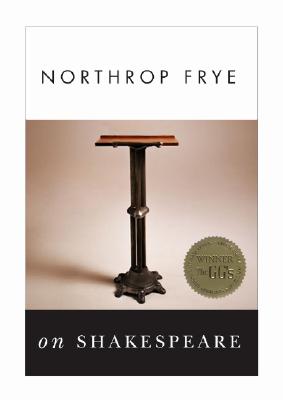 In addition to being one of the most important literary theorists of the 20th century, Northrop Frye was also a committed teacher. He developed the essays in this book from lectures he’d given to undergraduates in the Shakespeare course he co-taught at the University of Toronto. They are valuable guides to a number of the plays, and offer engaging examinations of such seemingly simple questions as who is the villain in Romeo and Juliet, or what the word “fool” means in King Lear.
In addition to being one of the most important literary theorists of the 20th century, Northrop Frye was also a committed teacher. He developed the essays in this book from lectures he’d given to undergraduates in the Shakespeare course he co-taught at the University of Toronto. They are valuable guides to a number of the plays, and offer engaging examinations of such seemingly simple questions as who is the villain in Romeo and Juliet, or what the word “fool” means in King Lear. - Shakespeare: The Invention of the Human, by Harold Bloom
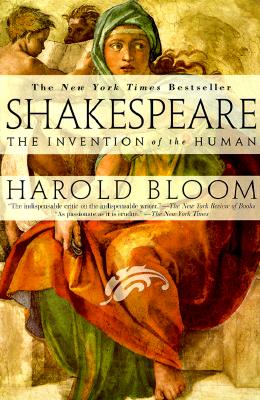 In this thick and opinionated tome, Harold Bloom, one of America’s major 20th century literary critics, provides commentary on each of Shakespeare’s plays, as he argues that William Shakespeare single-handedly created our modern understanding of humanity. One of the reasons I like this book is that, along with all his valuable insights, Bloom’s more outrageous observations keep challenging me to take a deeper look at the plays for myself so I can develop my own opinions.
In this thick and opinionated tome, Harold Bloom, one of America’s major 20th century literary critics, provides commentary on each of Shakespeare’s plays, as he argues that William Shakespeare single-handedly created our modern understanding of humanity. One of the reasons I like this book is that, along with all his valuable insights, Bloom’s more outrageous observations keep challenging me to take a deeper look at the plays for myself so I can develop my own opinions. - Shakespeare After All, by Marjorie Garber
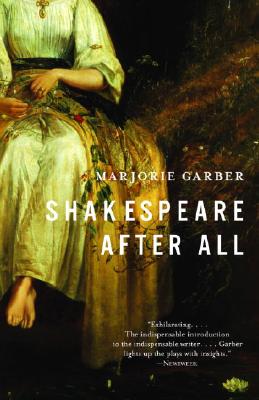 This is another helpful general introduction to each of the plays.
This is another helpful general introduction to each of the plays.
For Readers Who Want to Dig a Little Deeper:
- A Short History of Shakespearean Criticism, by Arthur M. Eastman
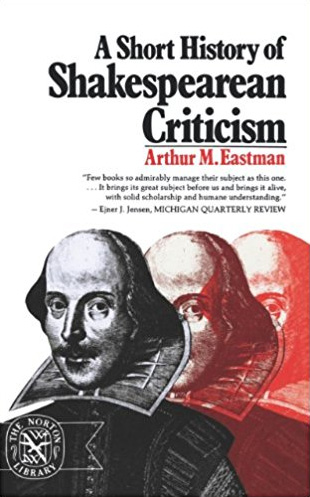 This overview of Shakespeare criticism begins with Shakespeare’s contemporary Ben Jonson, and ends with mid-20th century critics such as Northrop Frye and John Holloway. Eastman’s summaries of the points of view, contributions, and weaknesses of many of Shakespeare’s major critics are excellent introductions to these thinkers. In addition, we also can trace how critical questions, assumptions, and concerns have evolved over that 350-year span.
This overview of Shakespeare criticism begins with Shakespeare’s contemporary Ben Jonson, and ends with mid-20th century critics such as Northrop Frye and John Holloway. Eastman’s summaries of the points of view, contributions, and weaknesses of many of Shakespeare’s major critics are excellent introductions to these thinkers. In addition, we also can trace how critical questions, assumptions, and concerns have evolved over that 350-year span. - Shakespeare: An Anthology of Criticism and Theory 1945-2000, edited by Russ McDonald
 This collection of essays is organized by schools of criticism, introducing readers to some of the most influential Shakespearean scholars of the second half of the 20th century, while also giving them a sense of how various critical schools approach their subject.
This collection of essays is organized by schools of criticism, introducing readers to some of the most influential Shakespearean scholars of the second half of the 20th century, while also giving them a sense of how various critical schools approach their subject. - A Natural Perspective: The Development of Shakespearean Comedy and Romance, by Northrop Frye
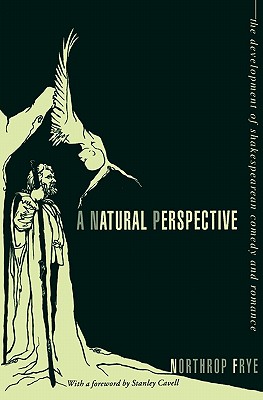 Northrop Frye used archetypal narrative structures and memes as a method for examining literature in a systematic way. One of the patterns he describes in A Natural Perspective is the “green world” structure that is so significant to both John and Miranda in my novel Still Time.
Northrop Frye used archetypal narrative structures and memes as a method for examining literature in a systematic way. One of the patterns he describes in A Natural Perspective is the “green world” structure that is so significant to both John and Miranda in my novel Still Time. - The Women’s Part: Feminist Criticism of Shakespeare, edited by Carolyn Ruth Swift Lenz, Gayle Greene, and Carol Thomas Neely
 Up until fairly recently, the great majority of Shakespeare critics, scholars, professors, and even theater professionals have been male. This welcome collection of essays is one of the first to consider the plays from a feminist perspective.
Up until fairly recently, the great majority of Shakespeare critics, scholars, professors, and even theater professionals have been male. This welcome collection of essays is one of the first to consider the plays from a feminist perspective.
Shakespeare’s language:
- Shakespeare’s Words: A Glossary & Language Companion, by David Crystal and Ben Crystal
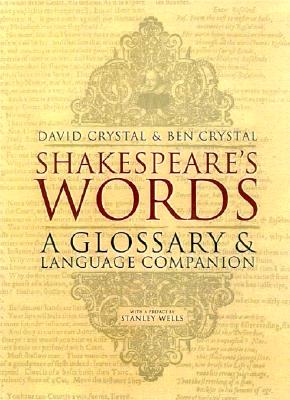 Any word in Shakespeare’s work that the authors thought might pose a comprehension problem to a modern reader is defined in Shakespeare’s Words, and all of that word’s occurrences in the plays are listed. Written by a father and son team, his amazingly thorough and friendly glossary makes me remember how my own father once referred to our family dictionary as “Webster’s book of short stories.”
Any word in Shakespeare’s work that the authors thought might pose a comprehension problem to a modern reader is defined in Shakespeare’s Words, and all of that word’s occurrences in the plays are listed. Written by a father and son team, his amazingly thorough and friendly glossary makes me remember how my own father once referred to our family dictionary as “Webster’s book of short stories.” - Think on My Words, by David Crystal
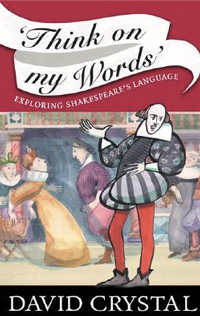 In this lively and very readable book, linguist and Shakespeare scholar David Crystal explores many aspects of Shakespeare’s language, from common myths concerning his vocabulary and linguistic inventiveness to issues of grammar, punctuation, and syntax. You might not expect a book about 16th century punctuation to be a page-turner, but this one is!
In this lively and very readable book, linguist and Shakespeare scholar David Crystal explores many aspects of Shakespeare’s language, from common myths concerning his vocabulary and linguistic inventiveness to issues of grammar, punctuation, and syntax. You might not expect a book about 16th century punctuation to be a page-turner, but this one is! - Shakespeare’s Imagery and What It Tells Us, by Caroline Spurgeon
 Caroline Spurgeon, the first female English literature professor in England, devoted many years to examining the imagery in Shakespeare’s plays. Her conclusions invite interesting speculations about his experiences and his interests, as well as yielding fascinating insights about how the images in Shakespeare’s plays work to build themes and reveal characters.
Caroline Spurgeon, the first female English literature professor in England, devoted many years to examining the imagery in Shakespeare’s plays. Her conclusions invite interesting speculations about his experiences and his interests, as well as yielding fascinating insights about how the images in Shakespeare’s plays work to build themes and reveal characters. - Shakespeare’s Language, by Frank Kermode
 In his Introduction, Kermode writes, “Every other aspect of Shakespeare has been studied to death, but the fact that he was a poet has somehow dropped out of consideration.” In the subsequent chapters, Kermode’s close and incisive examination of Shakespeare’s language leads to a deeper understanding and appreciation of his plays. (It also proves why attempts to “translate” Shakespeare into 21st century English are doomed to failure!)
In his Introduction, Kermode writes, “Every other aspect of Shakespeare has been studied to death, but the fact that he was a poet has somehow dropped out of consideration.” In the subsequent chapters, Kermode’s close and incisive examination of Shakespeare’s language leads to a deeper understanding and appreciation of his plays. (It also proves why attempts to “translate” Shakespeare into 21st century English are doomed to failure!)
Biographies of Shakespeare
- 1599: A Year in the Life of William Shakespeare, by James Shapiro
 Shapiro focuses on the year in which Shakespeare completed Henry the Fifth, wrote Julius Caesar and As You Like It, and started Hamlet as a way of giving readers a sense of who Shakespeare was, how he may have worked, and the turbulent and thrilling times in which he lived.
Shapiro focuses on the year in which Shakespeare completed Henry the Fifth, wrote Julius Caesar and As You Like It, and started Hamlet as a way of giving readers a sense of who Shakespeare was, how he may have worked, and the turbulent and thrilling times in which he lived. - Will in the World: How Shakespeare Became Shakespeare, by Stephan Greenblatt
 There is a great deal of speculation in Greenblatt’s biography of the “Surely Will must have,” or “Let us imagine that…” variety. On the one hand, all that fictionalizing that makes for entertaining reading, though it’s also definitely frustrating. I think the real value of this book is the way Greenblatt’s close readings illuminate passages from the plays.
There is a great deal of speculation in Greenblatt’s biography of the “Surely Will must have,” or “Let us imagine that…” variety. On the one hand, all that fictionalizing that makes for entertaining reading, though it’s also definitely frustrating. I think the real value of this book is the way Greenblatt’s close readings illuminate passages from the plays. - Shakespeare: The Biography, by Peter Ackroyd
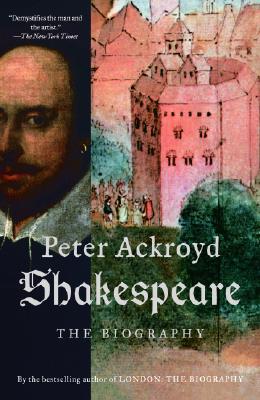 This is perhaps the most thorough of the biographies on this list. It’s also engaging to read, and Ackroyd’s insights about the plays and theater are valuable.
This is perhaps the most thorough of the biographies on this list. It’s also engaging to read, and Ackroyd’s insights about the plays and theater are valuable.
Novels
- Nothing Like the Sun, by Anthony Burgess
 I first read this fictionalized biography of Shakespeare’s life when I ran across it on the shelves of my small-town public library as a teenager. I remember being blown away by it, but also feeling like there was a lot going on that I didn’t entirely understand. Recently, I picked it up again with a great deal of trepidation. But I enjoyed my second reading as much as I remember enjoying my first. Alas, Burgess’s misogyny was much more striking this time around, but I was still swept up in his linguistic romps, his many slant references to the plays, and the persuasive, compelling, and flawed character that he creates for William Shakespeare.
I first read this fictionalized biography of Shakespeare’s life when I ran across it on the shelves of my small-town public library as a teenager. I remember being blown away by it, but also feeling like there was a lot going on that I didn’t entirely understand. Recently, I picked it up again with a great deal of trepidation. But I enjoyed my second reading as much as I remember enjoying my first. Alas, Burgess’s misogyny was much more striking this time around, but I was still swept up in his linguistic romps, his many slant references to the plays, and the persuasive, compelling, and flawed character that he creates for William Shakespeare. - Prospero’s Daughter, by Elizabeth Nunez
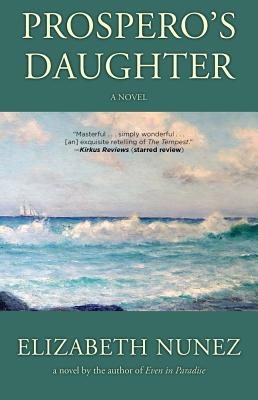
- Blaze Island, by Catherine Bush
 For those who loved Barbara Kingsolver’s Flight Behavior comes a new climate-themed, Shakespeare-inspired novel from bestselling author Catherine Bush.
For those who loved Barbara Kingsolver’s Flight Behavior comes a new climate-themed, Shakespeare-inspired novel from bestselling author Catherine Bush. - The Shakespeare Stealer, by Gary Blackwood
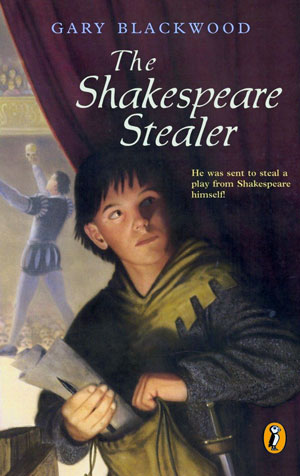 Between my husband’s career as an English professor, my work as a novelist, and my late parents’ and our three children’s passion for reading, books have always been among my family’s most prized possessions. After our home was destroyed in the Walbridge Fire in August 2020, one of the most difficult losses for me to try to come to terms with was the loss of all our books. In fact, as I was working on the claim to submit to our insurance company, I calculated that we’d lost over a football field’s length of bookshelves packed with books.
Between my husband’s career as an English professor, my work as a novelist, and my late parents’ and our three children’s passion for reading, books have always been among my family’s most prized possessions. After our home was destroyed in the Walbridge Fire in August 2020, one of the most difficult losses for me to try to come to terms with was the loss of all our books. In fact, as I was working on the claim to submit to our insurance company, I calculated that we’d lost over a football field’s length of bookshelves packed with books. - Less than a week after the fire, while my husband and I were couch-surfing with family in Chico, California, I happened to peek into the Little Free Library at the edge of Community Park, where I discovered a copy of The Shakespeare Stealer, a YA novel I’d often heard of but had never read. Especially since my most recent novel, Still Time, is also woven with references to Shakespeare, I decided to help myself that well-worn copy of The Shakespeare Stealer in hopes it might prove a welcome distraction in a difficult time.
- But before I’d even had a chance to open The Shakespeare Stealer, I received an email through my website from a reader named Gary Blackwood who wrote: “I just wanted to let you know how very much I enjoyed Still Time. Not only did it satisfy me intellectually, I connected with it emotionally, too; in fact, I teared up at least half a dozen times…. The book also spoke to me because I’m such a Shakespeare buff; my most popular YA novel is set in Shakespeare’s day, and Will figures prominently in it.”
- Even as I was basking in Gary’s words, my mind was racing ahead to wonder if the author of that generous message could actually be the author of The Shakespeare Stealer. As soon as I confirmed that my guess was correct, I wrote Gary to tell him that, in a coincidence that probably only two novelists could have concocted, his was currently the only book I owned!
- When Gary responded by observing that he thought “synchronicity” was an even more apt description than “coincidence” for our improbable connection, I instantly recognized him as a fellow devotee to the twinned worlds of stories and words. I began to read The Shakespeare Stealer that very night, and found to be a marvelous story – warm, wise, and fun, and packed so deftly with fascinating facts about Shakespeare’s life and times that I doubt most other readers would ever realize how much they were absorbing while they followed the page-turning exploits of a lonely teenaged orphan named Widge as he learns about loyalty and finds his first true home among the members of Shakespeare’s theater company.
- I am currently reading Shakespeare’s Scribe, the second book in Gary’s Shakespeare Stealer trilogy, and I’m finding it every bit as enthralling as The Shakespeare Stealer. I suspect that Gary might agree that the fact that Shakespeare’s Scribe is set in a “plague year” not unlike the one we are currently living through is yet another example of synchronicity—albeit of grimmer kind.
- But despite the unfortunate inciting incident of this tale of two novelists and fellow Shakespeare buffs, I will be forever grateful to that Community Park Little Free Library in Chico, California for introducing me to a fine new author, helping me to make an interesting new friend, and giving me some much-needed solace and inspiration in the midst of a challenging time.
Zines:
- Brief Candle
 According to the editors of this zine, “In the same way that Shakespeare’s plays were beloved by aristocrats and commoners, the nobility on cushions and the penny-paying groundlings, we wanted to create something that allowed people of any age, education level, or type of experience to share their thoughts about Shakespeare. We welcome the personal, the conversational, and the unconventional.”
According to the editors of this zine, “In the same way that Shakespeare’s plays were beloved by aristocrats and commoners, the nobility on cushions and the penny-paying groundlings, we wanted to create something that allowed people of any age, education level, or type of experience to share their thoughts about Shakespeare. We welcome the personal, the conversational, and the unconventional.”
Shakespeare Festivals and Plays:

- This page on the Shaksper.net website is an impressively comprehensive guide to national and international Shakespeare festivals and theaters.
Websites:
- PlayShakespeare is a vast site that includes the text and background information (synopsis, reviews, and additional documents) for every play; reviews of Shakespeare-related films, theatrical productions, and books; and an extensive discussion forum.
- The Shakespeare Standard is a lively online forum that “seeks to be the center of Shakespeare community and conversation on the web.” Resources range from scholarly articles and reviews of current productions to pop culture news.
- Searchable Shakespeare allows users to perform word, phrase, and character searches throughout all of Shakespeare’s plays and poems simultaneously. It was invaluable to me as I was writing Still Time.
- Shakespeare’s Words, the online companion to David Crystal’s and Ben Crystal’s book Shakespeare’s Words: A Glossary & Language Companion, is another resource I could not have written Still Time without. (For a fuller description of Shakespeare’s Words, see the book annotation below.)
- Folger Library in Washington DC houses the world’s largest Shakespeare collection and is also a world-class Shakespeare theater. Online, it offers much that might be of interest to students, teachers, and scholars.
- Shakesper: Global Electronic Shakespeare Conference is “an edited and moderated international e-mail distribution list for discussion among Shakespearean scholars, researchers, instructors, students, and anyone sharing their academic interests and concerns.”
- The Sonnet Man, aka Devon Glover, is a brilliant rapper who brings Shakespeare’s sonnets and soliloquies to life in exciting new ways.
- Good Tickle Brain: These comics by Mya Gosling are as entertaining as they are insightful.

For Über Geeks
 Click on any line in any of the plays on JSTOR: Understanding Shakespeare, and you will instantly get links to all the scholarly articles on the academic digital library JSTOR that reference that particular line. For the right person, this can be an extremely seductive rabbit hole!
Click on any line in any of the plays on JSTOR: Understanding Shakespeare, and you will instantly get links to all the scholarly articles on the academic digital library JSTOR that reference that particular line. For the right person, this can be an extremely seductive rabbit hole!
Blogs
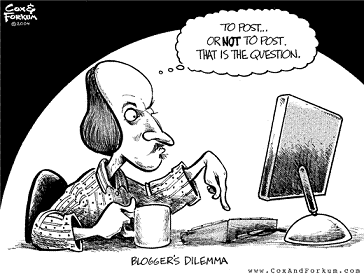 Bill Walthall, who blogs at The Bill Shakespeare Project is a former high school English, Shakespeare, and Drama teacher. Bill writes engaging posts and creates weekly podcasts about his experience with each of Shakespeare’s plays, from The Comedy of Errors through The Tempest.
Bill Walthall, who blogs at The Bill Shakespeare Project is a former high school English, Shakespeare, and Drama teacher. Bill writes engaging posts and creates weekly podcasts about his experience with each of Shakespeare’s plays, from The Comedy of Errors through The Tempest.- KL, the blogger for Bardfilm: The Shakespeare and Film Microblog, shares thoughtful and well-informed responses to “films, plays, and other matters related to Shakespeare.”
Audio
 Speak the Speech
Speak the Speech
Listening to a good reader read Shakespeare aloud can be as powerful an experience as attending a performance. Also, many people encountering Shakespeare for the first time find that following along on the page while a skilled reader reads Shakespeare’s lines aloud can really help those lines come alive. There isn’t an audio version for every play on this site, but those that are available are not only free, but are also very nicely read.- Original Pronunciation
“Original Pronunciation” refers to the accent that the actors during Shakespeare’s time would have used. Linguist and Shakespeare scholar David Crystal and actor Ben Crystal have created this website to explain OP, and let us hear some fascinating samples of Shakespeare’s accent.
More Cool Stuff
- Shakespeare’s World
On this website, volunteers can transcribe handwritten documents by Shakespeare’s contemporaries that will help scholars to understand his life and times. - Shakespeare Geek’s Definitive List of Shakespeare Knock-Knock Jokes
The (Foolish) Authorship Question
- The Shakespeare Authorship Page: Dedicated to the Proposition that Shakespeare Wrote Shakespeare
- 60 Minutes with Shakespeare
This page from the Blogging Shakespeare website is devoted to examining the question of who wrote Shakespeare’s plays. (Answer: a brilliant glover’s son from Stratford-Upon-Avon named William Shakespeare.)
Retellings of the Plays:
- Tales from Shakespeare, by Charles and Mary Lamb
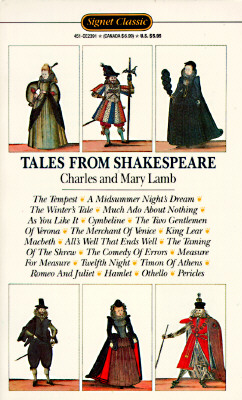 First published over two hundred years ago, this classic contains the Lambs’ retelling of twenty of Shakespeare’s plays. In their Preface, they describe their commitment to use Shakespeare’s words “whenever it seemed possible.” The resulting stories are not only entertaining in their own right, but also do an excellent job of introducing children (and perhaps their adults…) to the plays.
First published over two hundred years ago, this classic contains the Lambs’ retelling of twenty of Shakespeare’s plays. In their Preface, they describe their commitment to use Shakespeare’s words “whenever it seemed possible.” The resulting stories are not only entertaining in their own right, but also do an excellent job of introducing children (and perhaps their adults…) to the plays. - The Best of Shakespeare: Retellings of 10 Classic Plays, by E. Nesbit
 Nesbit’s retellings are brief, pleasantly opinionated (King Leontes of Sicily was a “violent-tempered man and rather silly”), and easy to follow.
Nesbit’s retellings are brief, pleasantly opinionated (King Leontes of Sicily was a “violent-tempered man and rather silly”), and easy to follow. - The Tempest, retold by Franzeska Ewart
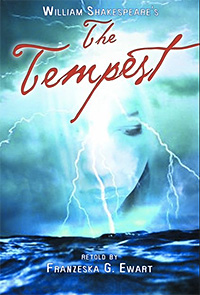 One of publisher A & C Black’s “Shakespeare Today” series, which retells Shakespeare’s plays in novel form for middle readers, this version of The Tempest is very engagingly told from Ariel’s point of view. It employs a lot of Shakespeare’s language and casually invites readers to reflect on themes such as love, loyalty, ambition, captivity, and freedom.
One of publisher A & C Black’s “Shakespeare Today” series, which retells Shakespeare’s plays in novel form for middle readers, this version of The Tempest is very engagingly told from Ariel’s point of view. It employs a lot of Shakespeare’s language and casually invites readers to reflect on themes such as love, loyalty, ambition, captivity, and freedom.
Picture Books:
- The Tempest, retold by Ann Keay Beneduce, illustrated by Gennady Spirin
Spirin’s illustrations are ravishing! - A Midsummer Night’s Dream, retold by Bruce Coville, illustrations by Dennis Nolan
- Romeo and Juliet, illustrated by Margaret Early
- Brick Shakespeare: Four Tragedies and Four Comedies, by John McCann, et. al
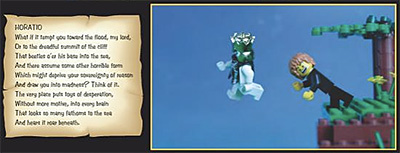 All the action in these eight plays is depicted through dialogue from the plays and photos of Lego figures in appropriate poses. With the exception of brief summaries at the beginning of each scene, there are no explanations of the language or descriptions of what’s going on in the plot. Hence, I’m not sure these would be very helpful introductions to someone who didn’t already have at least a little familiarity with the plays. But I find the image of a Lego Macbeth confronting three Lego Witches or a Lego Romeo courting a Lego Juliet to be pretty darn amusing!
All the action in these eight plays is depicted through dialogue from the plays and photos of Lego figures in appropriate poses. With the exception of brief summaries at the beginning of each scene, there are no explanations of the language or descriptions of what’s going on in the plot. Hence, I’m not sure these would be very helpful introductions to someone who didn’t already have at least a little familiarity with the plays. But I find the image of a Lego Macbeth confronting three Lego Witches or a Lego Romeo courting a Lego Juliet to be pretty darn amusing!
Animation:
- Shakespeare: The Animated Tales
 Each of the plays in this series has been animated as a half hour film by the leading directors of Russia’s Christmas Films. Actors from the Royal Shakespeare Company provide voices for the characters, and the resulting twelve films do an excellent job of using Shakespeare’s language and simple summaries to introduce youngsters to the plots, characters, and themes in each play.
Each of the plays in this series has been animated as a half hour film by the leading directors of Russia’s Christmas Films. Actors from the Royal Shakespeare Company provide voices for the characters, and the resulting twelve films do an excellent job of using Shakespeare’s language and simple summaries to introduce youngsters to the plots, characters, and themes in each play.
Films:
- Shakespeare’s Globe Theater has made films of quite a few of its productions available for rental or purchase.
 Twelfth Night or What You Will (1996). Trevor Nunn, director.
Twelfth Night or What You Will (1996). Trevor Nunn, director.- Much Ado About Nothing (1993). Kenneth Branagh, director.
- The Merchant of Venice (2004). Michael Radford, director (Al Pachino as Shylock).
- A Midsummer Night’s Dream (1935). Max Reinhardt and William Dieterle, directors (Mickey Rooney as Puck).
- Richard III (1995). Richard Loncraine, director (Ian McKellen as Richard III).
 The Hollow Crown. This series of BBC television film adaptations of the eight history plays from Richard II to Richard III includes such fine actors as Patrick Stewart, Judi Dench, Jeremy Irons, David Suchet, and Benedict Cumberbatch.
The Hollow Crown. This series of BBC television film adaptations of the eight history plays from Richard II to Richard III includes such fine actors as Patrick Stewart, Judi Dench, Jeremy Irons, David Suchet, and Benedict Cumberbatch.- Still Dreaming. This inspiring 2014 documentary is about a group of retired entertainers living at the Lillian Booth Actors Home outside of Manhattan who set out to stage a production of A Midsummer Night’s Dream. As it chronicles the elderly performers’ efforts to cope with the challenges posed by both ensemble work and also by old age, the film celebrates the gifts that theater—and Shakespeare—can give to people of all ages.
- Shakespeare Behind Bars. This award-winning documentary is a record of the potentially life-changing work that the Shakespeare Behind Bars program does with incarcerated adults and youth.
Sitcoms:
- Upstart Crow
 The episodes in Upstart Crow tell the story of Will Shakespeare as an up-and-coming playwright, trying to keep his family happy in Stratford while he writes plays and spars with other dramatists in London. It’s light-hearted—and even goofy—but each episode is crammed with references to Shakespeare’s plays, his times, and theatrical politics, and I think it’s lots of fun. I also like that—for once!—Will’s wife Anne is not portrayed as a shrew, and also that Will’s London landlord’s daughter keeps trying find a way to circumvent the convention that won’t allow women to act onstage.
The episodes in Upstart Crow tell the story of Will Shakespeare as an up-and-coming playwright, trying to keep his family happy in Stratford while he writes plays and spars with other dramatists in London. It’s light-hearted—and even goofy—but each episode is crammed with references to Shakespeare’s plays, his times, and theatrical politics, and I think it’s lots of fun. I also like that—for once!—Will’s wife Anne is not portrayed as a shrew, and also that Will’s London landlord’s daughter keeps trying find a way to circumvent the convention that won’t allow women to act onstage. - Slings and Arrows
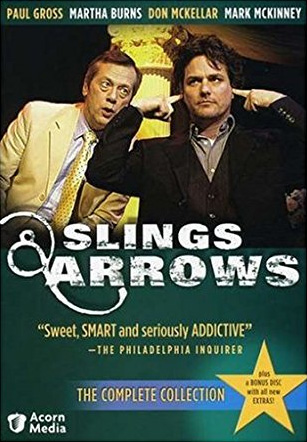 The Canadian TV series Slings and Arrows is about the members of an acclaimed Shakespeare Festival as they deal with the challenges of putting on a play, getting along with each other, staying true to themselves, and trying to keeping their festival afloat.
The Canadian TV series Slings and Arrows is about the members of an acclaimed Shakespeare Festival as they deal with the challenges of putting on a play, getting along with each other, staying true to themselves, and trying to keeping their festival afloat.